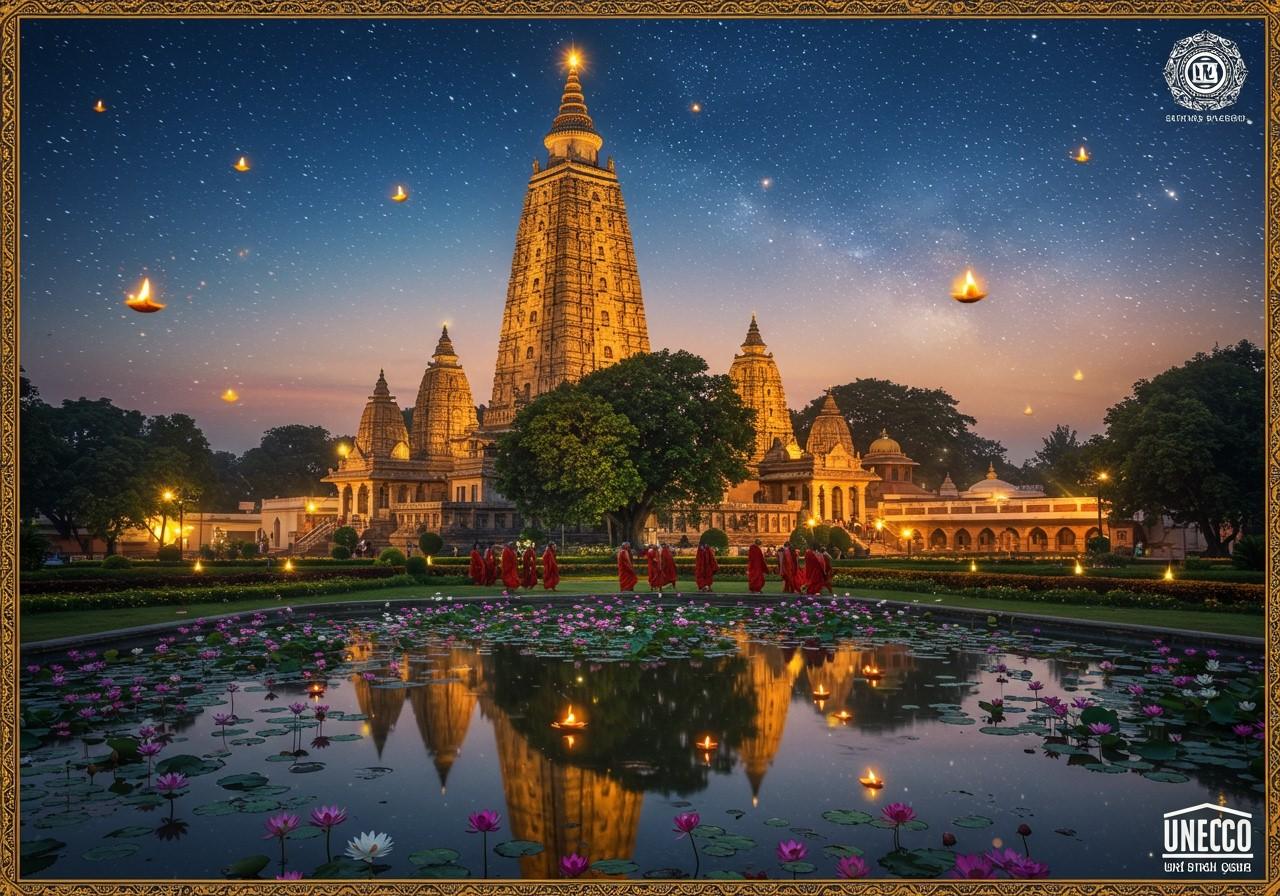
The Mahabodhi Temple, nestled in Bodh Gaya, Bihar, India, holds immense significance as a UNESCO World Heritage Site and one of Buddhism’s holiest places. It marks the very spot where Siddhartha Gautama, the Buddha, is believed to have reached enlightenment. The initial temple, constructed by Emperor Asoka in the 3rd century BC, paved the way for the current structure, which dates back to the 5th or 6th centuries. This sacred site also houses a revered tree, believed to be a descendant of the original Bodhi Tree under which Buddha attained enlightenment.
Historical Significance
The Mahabodhi Temple boasts a rich history, stretching back to the 3rd century BC when Emperor Asoka first established it. Over the centuries, dynasties like the Guptas and Palas contributed to its architectural evolution, solidifying its role in the spread of Buddhism across Asia. Numerous renovations and restorations have preserved its structure and sanctity, while archaeological discoveries have illuminated its past. The temple’s mystique is further enhanced by the legends and myths associated with it.
UNESCO World Heritage Status
The Mahabodhi Temple earned its place on the UNESCO World Heritage list in 2002 due to its exceptional cultural, historical, and architectural value. This prestigious recognition brings global attention, preservation efforts, and increased tourism, with international and local initiatives working together to protect the site. Legal and administrative frameworks ensure the ongoing conservation of this sacred space.
Architectural Highlights
The temple’s architecture is truly unique, featuring a main stupa that stands tall at 55 meters, adorned with intricate carvings and sculptures. Symbolic design elements, like the lotus motif, represent purity and enlightenment. The Bodhi Tree, a direct descendant of the one under which Buddha attained enlightenment, holds profound significance. Other notable features include the Vajrasana (Diamond Throne) and the Animeshlocha Stupa. The architecture beautifully blends various cultural influences accumulated over time.
Visitor Experience
Planning a visit? Early mornings or late afternoons offer a more tranquil experience. A nominal fee or permit may be required for entry. Guided tours provide in-depth insights, while nearby accommodations and dining cater to all budgets. Extend your journey by exploring other local attractions like the Great Buddha Statue and various Buddhist monasteries in Bodh Gaya. Remember to respect local customs and etiquette during your visit.
Cultural and Spiritual Importance
Daily rituals and prayers create a vibrant spiritual atmosphere at the Mahabodhi Temple. Monks and devotees from around the world gather to meditate, chant, and pay their respects, fostering a sense of peace and connection.
The temple holds immense significance for Buddhists globally, with pilgrims tracing Buddha’s footsteps. Buddha Purnima, celebrating Buddha’s birth, enlightenment, and passing, is a particularly vibrant time. Festivals showcase the temple’s cultural richness, with lantern-lit evenings and prayer flags adding to the atmosphere.
Educational programs at the temple share Buddhist teachings through workshops and lectures on meditation, compassion, and mindfulness. These programs promote spiritual growth and provide valuable insights. The local community benefits from the temple’s presence, with tourism boosting the economy and supporting local businesses and artisans. Traditional practices and crafts are also preserved.
Personal accounts from pilgrims often describe a sense of calm and inspiration, highlighting the temple’s role as a place of spiritual awakening. Observing local customs, such as modest dress, removing shoes before entering, and maintaining silence in prayer areas, demonstrates respect and enhances the experience.
How Poojn.in Enhances Your Visit
Poojn.in, India’s leading online store for cultural goods and services, offers a wide selection of items ideal for Buddhist rituals and offerings at the Mahabodhi Temple. Enhance your spiritual journey with:
-
Pure butter lamps and ghee: Illuminate your devotion with authentic offerings. Find pure ghee and other puja essentials on Poojn.in.
-
Authentic incense sticks and holders: Deepen your meditation with fragrant traditional incense. Explore a variety of incense on Poojn.in.
-
Traditional prayer beads (mala): Crafted from sacred materials to enhance your prayers. Discover beautiful malas on Poojn.in.
-
Cotton wicks for butter lamps: Ensure a clean and steady flame for your offerings. Browse puja samagri on Poojn.in.
-
Fresh flowers: Offer vibrant blossoms at the temple altars. Find fresh flowers and other offerings on Poojn.in.
-
Prayer flags: Adorn the temple with colorful flags bearing Buddhist mantras and symbols. Shop for prayer flags and more on Poojn.in.
Poojn.in provides quality-assured items with secure packaging and doorstep delivery across India, making it convenient for pilgrims to prepare for their visit. Visit Poojn.in’s Buddhist section today!
Conclusion
The Mahabodhi Temple stands as a testament to cultural and spiritual richness. Its UNESCO World Heritage status draws visitors worldwide, and its rituals, festivals, and educational programs offer profound experiences. Honor the local customs, and your visit will be a memorable journey of peace and inspiration. Learn more about other spiritual destinations in India.
FAQs
What is the Mahabodhi Temple? The Mahabodhi Temple is a renowned Buddhist temple in Bodh Gaya, India, where Buddha attained enlightenment.
Why is it important? It marks the spot of Buddha’s enlightenment, a key pilgrimage site for Buddhists.
When was it listed by UNESCO? The temple was designated a UNESCO World Heritage Site in 2002.
Why is it a World Heritage Site? Its historical, spiritual, and architectural significance, representing Buddha’s enlightenment with ancient structures and inscriptions, earned it this status.
Can visitors tour it? Yes, it’s open to tourists and pilgrims.
What can you see there? The main temple, the Bodhi tree, shrines, and gardens are key attractions.
How do you reach it? Bodh Gaya is accessible by road, rail, and air (nearest airport: Gaya).
Is there an entry fee? No entry fee, but donations are welcome.


